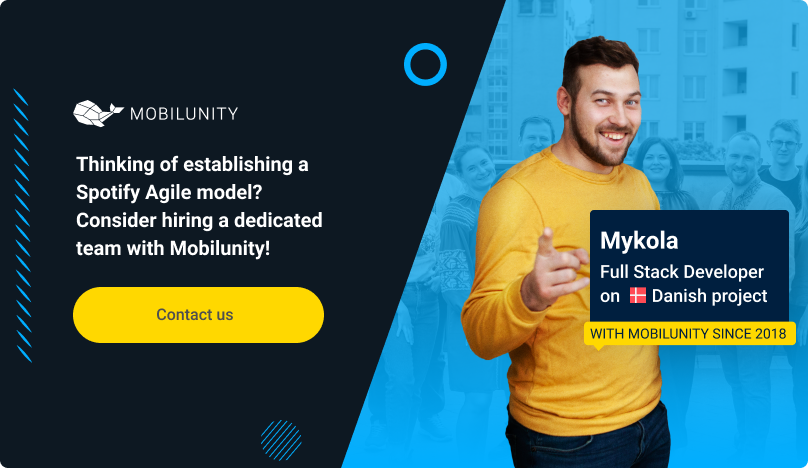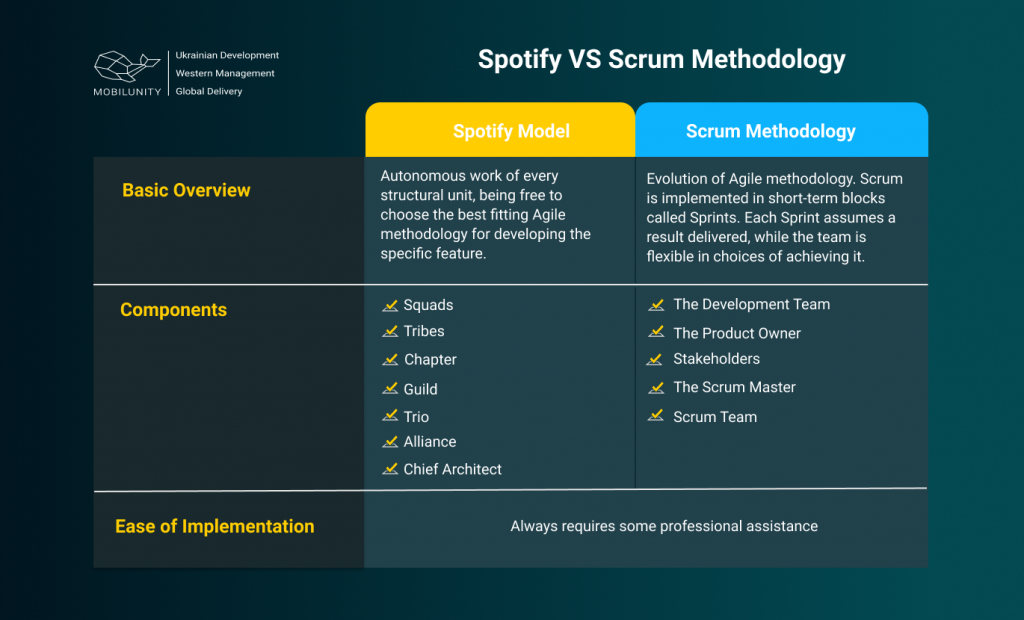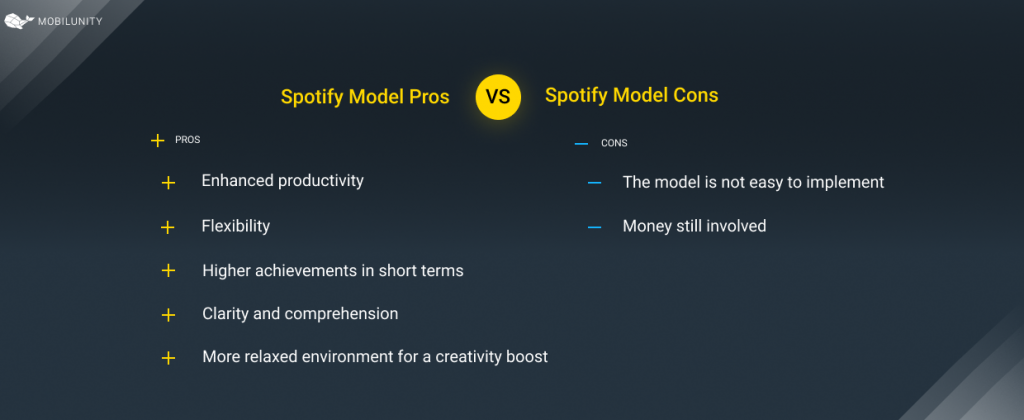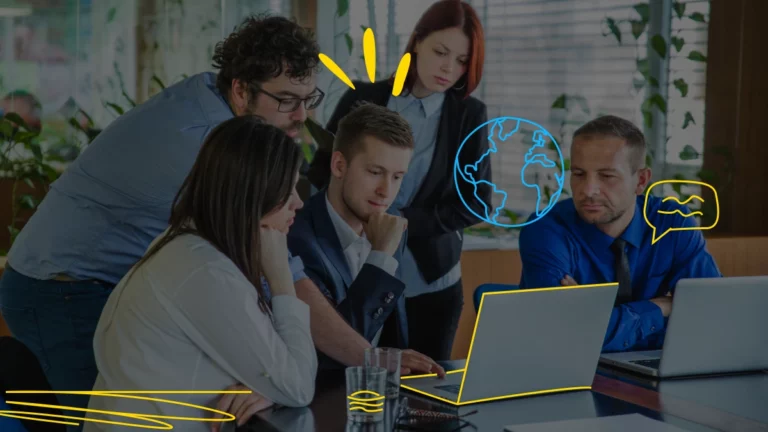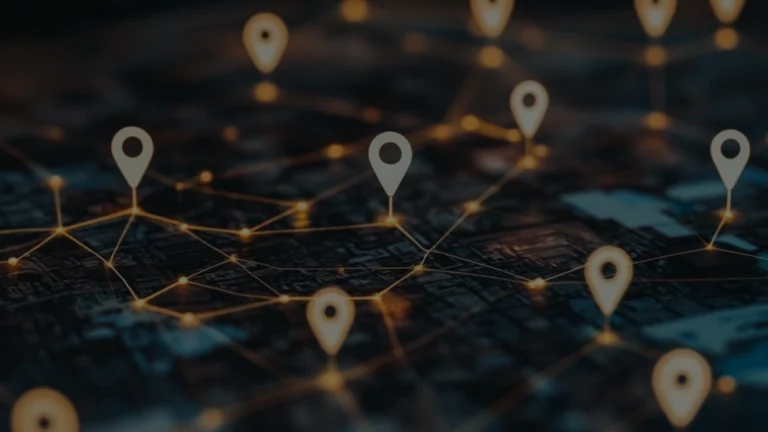Spotify Agile Model: Key Benefits
Do you know what makes you and people from Burundi, New Zealand, Namibia, Mauritius, or pretty much every other country around the Globe similar? Well, passion for listening to music and various kinds of podcasts on Spotify – might be the answer to the question posed. Presently Spotify is the Global most utilized audio-streaming platform: 365M users (June 30, 2021).
If some numbers start popping, let’s look at more recently gotten data brought to the table:
- Playlists – 4 billion
- Podcasts – 2.9 million
- Tracks – 70 million
- Subscribers – 165 million
- Revenues paid – €21+billion
Success? Obviously. Apparently, the recipe with the secret ingredient is revealed to everybody willing to try. Let’s dig deeper to learn what is unique about the Spotify business model that makes the company keep rocking for more than a decade.
Spotify Agile Model
Martin Lorentzon, alongside Daniel Ek felt really uncomfortable about piracy in the music industry. They came up with the idea that was supposed to prevent privacy movement in getting favorites to listen yet still keep the option available to a massive audience. Things started getting feasible in 2006 – Spotify entered its development stage.
The release took place in 2008. The platform posed itself as a free hub with advertising though. The Spotify team had a plan to charge affordable money (around €12) for an ad-free experience. The platform, however, did not conquer piracy (an unattainable goal in general) yet has become a service capacity to support the music realm while making users happy.
With all the controversies singers-wise and some competitive issues, the company has managed to occupy 178 markets and keep on upgrading, adding new features keeping the audience constantly involved. Spotify organization permits developing a workflow the way it can produce the aimed results.
Starting small, the company was set to adopt Agile methodologies, which first worked perfectly well. With time, the company grew and when the optimal number of members for an Agile team exceeded the norm, the Spotify management team had to invent the Spotify organizational structure that will still be based on the Agile principles, yet have some peculiarities that will fit the company exactly.
Bringing the scaling Agile Spotify method to life has influenced the company’s consolidated position on the market productivity and human-wise. Spotify team structure is defined by autonomy, trust, and sensible independence. When people are placed in such a working environment, be it distributed Agile teams, or, the luxury, in-house specialists only, they thrive when their competence is not questioned but constantly encouraged.
Let’s see how the Spotify model Agile organization gets to be unfolded.
Spotify Model Structure
Spotify engineering model is a pure representation of autonomous simplicity resulting in sky-rocketing efficiency. Spotify Scrum structure is not something newly invented since the scrum methodology is rooted and followed. Yet, the modifications are what make the Spotify development model keep shaking the market and maintaining the interest of every developer role in Agile.
Here are the puzzles of an excellent Spotify organizational structure:
Squads
Spotify squads are similar to scrum teams, representing a group of IT talents having an assignment and working on it while choosing the Agile methodologies that they consider to be the most effective for the exact tasks’ needs. The number of workers varies from 6 to 12 people having one feature to deal with. Spotify management within the squads is defined by the presence of an Agile coach that monitors the work as a part of a team but not somebody above. Smooth work processes enable the creation of infrastructure for the team to reach the goal.
Tribes
When a certain number of Squads are assigned to work in a similar feature environment, it is combined into tribes, helping to monitor the squad development to be on the same page within the squad collective. The tribe’s volume is composed of 40 to 150 specialists. The tribe’s lead ensures smooth experiences in terms of staying on the goal.
Chapter
According to Spotify company culture, autonomy is a principle to build work by. Yet, it does not hurt if the squads’ specialists will utilize the best project development practices to keep the general picture of the process on the same page. The senior Tech lead will provide guidance and technology support for a more enhanced process, result-oriented-wise.
Guild
One might perceive it as a center of excellence, or interest club, meaning that if there are people strongly enthusiastic about certain professional aspects that might form a Guild and share the experience, opinions, cases, examples, etc. This group is voluntary and can be created by anybody wishing to do so. Usually, that one will be assigned as a coordinator to facilitate and regulate the group’s needs.
Trio
Tribe Lead, Product Lead, and Design Lead will form a trio to regulate the harmony features development considering these three facets. Each tribe has such a unit that is of great help when it comes to keeping things, development-wise, under the same roof.
Alliance
This group pretty much has it in the name itself – several cooperative units. The Tribe Trios will be those units. Their cooperation is a must for making sure that the tribes are staying on each separate goal to achieve the bigger one amid the project development.
Chief Architect
Chief Architect is a crucial part of the whole structure. This specialist is aimed at dealing with all things architectural, ensuring the issues resolution and risks mitigation.
Spotify Agile model presents no difficulty in understanding how to organize the employees for the greater result. Further down the line, we will see whether it may work for your company and whether the values of the structure might be easily projected on the organization of your company.
Spotify VS Scrum Methodology
Pros and Cons of the Spotify Model
As it’s been mentioned before, the Spotify Model is based on autonomy and minimum control. As surprising as that, such an approach helps to achieve the following:
If to speak about challenges, we might ask such questions as:
- Is the management ready to give a sheer amount of freedom?
- Will the project benefit from such a structure?
- Is the company ready to shift towards the system, mentally and resource-wise?
Simply copying the Spotify business model might not do good to a company, especially with specialists who have merged with that environment. There’s a chance you might need your own system, similar to what Spotify did when their needs exceeded the Agile potential as it is.
At the same time, it might become a long-looked-for solution to the business optimization that was lacking for more maximized outcomes.
Make sure to research and analyze thoroughly, or engage a third-party opinion of experts who might provide more light on the issue.
Spotify Agile Project Manager Resume Sample
Typical responsibilities of Spotify project manager are:
- Agile mindset cultivation among the Tribe members
- Agile expertise spreading: workshops, presentations, pieces of training
- HR and line managers support
- Tribe and Squads coaching on solving problems and roadblocks
- Applying data-driven approach
- Building boards and design reports to Tribes and Squads
- Contribution to the Agile Guilds
- Conflict resolutions
- Common Ceremonies facilitation
This is something you might be looking at when hiring Spotify Agile PM for the project. Even if you do not really have an in-house team of specialists working for you, you might turn to the companies providing dedicated teams, requesting the one that will work following the Spotify Agile organization model. Even turning to reliable vendors, you get to browse through candidates’ resumes for the job and see whether they have potential.
Mobilunity As a Reliable Vendor
Mobilunity is an experienced and reliable vendor; many companies around the globe entrust hiring dedicated development teams to us. Our clients include Canadian FinTech company FinExpert, French online restaurants reservation platform Zenchef, a Swiss provider of Geospatial Solutions Camptocamp, and many more. Our clients value our passion and ability for fast solutions. We are proud of:
- 10+ of proven and acknowledged experience
- 200+ successfully accomplished projects
- 40+ of satisfied clients whose staff requirements were met exactly
- 20+ countries for consolidated cooperation
Mobilunity’s services have helped to earn a high-profile, massively competitive image that keeps getting stronger due to the robust belief system of happy people. Happy customers alongside happy development specialists compose a proven recipe for the success and growth of all the parties involved.
Mobilunity keeps its strong position of being a great servant of the community in terms of providing great service when it comes to a software development partnership.
Looking for a dedicated team of proven IT specialists that will be able to adopt Spotify’s organizational structure? Contact us!
Disclaimer: All salaries and prices mentioned within the article are approximate numbers based on the research done by our in-house Marketing Research Team. Please use these numbers as a reference for comparison only. Feel free to use the contact form to inquire on the specific cost of the talent according to your vacancy requirements and chosen model of engagement.
